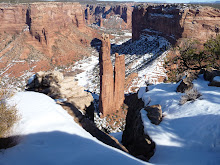A little about the town of Ajo. There is a difference of opinion among historians regarding the name of the town. One says that the Tohono O'odham Indians called the region au 'auho (meaning 'paint') for the copper-rich soil that produced a red color. Others say Mexican miners named it Ajo for the wild garlic. Either way, it was the copper that brought Americans to the region in the mid-1800s. It is pronounced AH-ho.
If you look at a Google map satellite view of the town, you will see two areas that look like giant craters. They're actually very unsettling to look at--appearing almost alien in nature. These are the open-pit mines, which today are abandoned and contain water at the bottom. Unfortunately, they're right up against the town, which makes me worry about the water quality. Copper mining has taken place here off and on since the town was settled, and up until about 1983 according to a local resident who informed me of some of this history. I believe I've read that there is some movement afoot to re-establish the mining now, also. I don't know whether these pits were the original mineworks, or the modern ones.
What took place in 1983, according to my informant, was a strike against the mining company that was the local version of the Civil War. 'Brother against brother' was the way she described it. Supporters of the mining company were employed elsewhere, but strikers remained here after the mine was closed. Because there was no commerce without the mine, the economic results are still visible in the run-down condition of most commercial establishments, and the continuing welfare attitude of some of the residents that we have encountered. I was told by one woman (who makes a living selling sofas and beds out of her living room) that one of her daughters 'couldn't' work because her husband made too much money and they 'were having to pay in.' Taxes, I assume.
The economic base now appears to be the 'snowbirds'--mostly senior citizens who come here for the mild winter weather and leave during the summer--and the government. Surrounding the area are an Air Force base, the Tohono O'odham reservation, a wildlife preserve and the national monument. Forty miles south is one of the major routes into and out of Mexico. So we have Border Patrol as well as employees of the Park Service, Forest Service and right now tons of contractors who are working to make the border less permeable.
As for the snowbirds, my landlady told us that Ajo is known as 'poor man's' Arizona. It is less expensive to live here than in Casa Grande, any of the bigger cities like Phoenix, Tucson and their suburbs, or the better-known resort areas. With Mexico just 40 miles south, 90 miles to the resorts of the northern coast of the Gulf of Baja California, and the outskirts of Phoenix or Tucson just an hour and a half north or east, it isn't too inconvenient to live here. Unlike Chinle, there are some shopping and services. While there is still only one store you would call a grocery store, there are two 'dollar store' chains with a presence here, Family Dollar and Dollar General. There is also a Radio Shack and a Tru-Value hardware store. Numerous thrift stores, a couple of gift shops and/or Mexican imports, a Napa auto parts, several restaurants, and undoubtedly others I haven't noticed yet make it possible to get by for almost any emergency needs. Unfortunately, everything, including the restaurants, are closed by 6 or 8 p.m. I think I need to teach these people how they should do commerce in a hot climate! They should be closing between ten a.m. and four p.m., and then re-opening until at least ten p.m. for shopping in the cool of the evening.
Well, that's enough for today. Time for my walk.

No comments:
Post a Comment